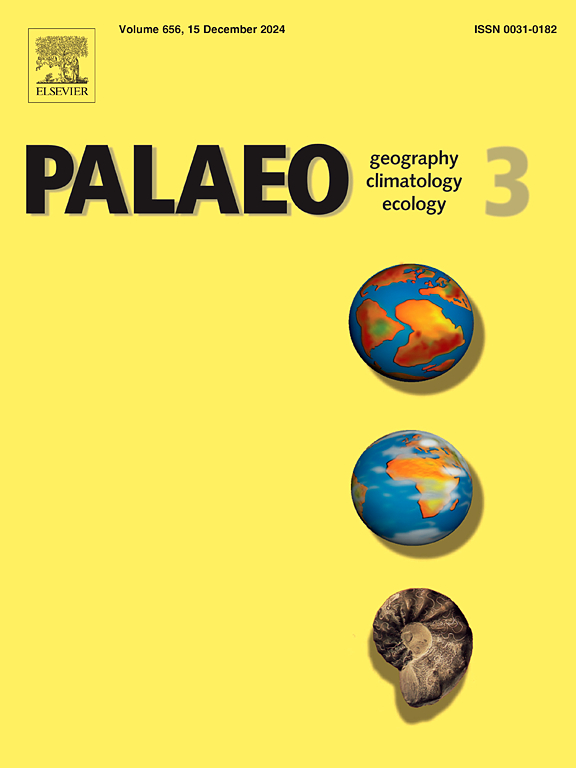Paleomonsoon variability during the past seven centuries: Insights from a northwest Himalayan lake
IF 2.6
2区 地球科学
Q2 GEOGRAPHY, PHYSICAL
Palaeogeography, Palaeoclimatology, Palaeoecology
Pub Date : 2025-03-20
DOI:10.1016/j.palaeo.2025.112911
引用次数: 0
Abstract
Monsoon rainfall in the northwest (NW) Himalaya is influenced by a complex interplay of various forcing factors, controlling diverse agrarian practices. The NW Himalaya receives the bulk of its rainfall from the Indian summer monsoon (ISM) with a small amount of precipitation originating from the westerlies during winter. To understand ISM variability in the last millennium, a 1 m long core was raised from Tikkar Taal Lake in the Panchkula district of Haryana, India and examined for multiple proxies (grain size, major and trace element ratios, stable isotope (δ13Corg) and Total Organic Carbon (TOC Wt). The statistical analyses, including End Member Modelling (EMM), correlation matrix, spectral analysis, Wavelet Transform Coherence (WTC) Analysis along with Continuous Wavelet Transform (CWT) analysis reveal significant changes in the Little Ice Age (LIA) and Current Warm Period (CWP). Accelerator Mass Spectrometry (AMS) 14C dates of three bulk sediment and two gastropod samples give an age range of ∼700 years. Pacific Decadal Oscillation (PDO) along with El Niño -Southern Oscillation (ENSO) and North Atlantic Oscillation (NAO) are the forcing factors for changes in precipitation. Two climatically significant intervals are identified, LIA (∼1296–1850 CE) with a moderately wet and humid phase from ∼1296 to 1500 CE, followed by a moderately dry phase from ∼1500 to 1850 CE overlapped by the Maunder Minimum (∼1645–1710 CE). The CWP is characterized by humid conditions (1850 CE onwards) coinciding with human-induced changes in the environment. The spectral analysis shows NAO and PDO like cyclicities of 15, 16, 18,19,22 and 28 yrs.
过去七个世纪的古季风变率:来自喜马拉雅西北部湖泊的洞察
喜马拉雅西北(NW)的季风降雨受到各种强迫因素的复杂相互作用的影响,这些因素控制着不同的农业实践。西北喜马拉雅地区的大部分降水来自印度夏季风,冬季有少量降水来自西风带。为了了解ISM在过去一千年中的变化,我们从印度哈里亚纳邦Panchkula地区的Tikkar Taal湖提取了一个1 m长的岩心,并检测了多个指标(粒度、主要元素和微量元素比、稳定同位素(δ13Corg)和总有机碳(TOC Wt))。统计分析(End Member Modelling, EMM)、相关矩阵、光谱分析、小波变换相干性(WTC)分析以及连续小波变换(CWT)分析)揭示了小冰期(LIA)和暖期(CWP)的显著变化。三个散装沉积物和两个腹足类样本的加速器质谱(AMS) 14C测年结果显示其年龄范围为~ 700年。太平洋年代际振荡(PDO)与厄尔尼诺Niño -南方涛动(ENSO)和北大西洋涛动(NAO)是降水变化的强迫因子。确定了两个具有气候意义的时间间隔,LIA (~ 1296 - 1850 CE)在~ 1296 - 1500 CE期间具有中度湿润和湿润阶段,其次是在~ 1500 - 1850 CE期间具有中度干燥阶段,与蒙德极小期(~ 1645-1710 CE)重叠。CWP的特点是潮湿条件(1850年起)与人类引起的环境变化相吻合。光谱分析显示NAO和PDO的周期分别为15、16、18、19、22和28年。
本文章由计算机程序翻译,如有差异,请以英文原文为准。
求助全文
约1分钟内获得全文
求助全文
来源期刊
CiteScore
5.90
自引率
10.00%
发文量
398
审稿时长
3.8 months
期刊介绍:
Palaeogeography, Palaeoclimatology, Palaeoecology is an international medium for the publication of high quality and multidisciplinary, original studies and comprehensive reviews in the field of palaeo-environmental geology. The journal aims at bringing together data with global implications from research in the many different disciplines involved in palaeo-environmental investigations.
By cutting across the boundaries of established sciences, it provides an interdisciplinary forum where issues of general interest can be discussed.

 求助内容:
求助内容: 应助结果提醒方式:
应助结果提醒方式:


